Ultimate Weight Bench Guide: All To Know Before Buying
Author:
Reviewed by:
(Head of Sport Science, 20 years of Oly Lifting experience, PhD Sport Science)
Unlock your full potential by engaging with our experts and community! Have questions about your fitness journey or looking for expert advice on weightlifting techniques? Don’t hesitate — leave a comment below and Oleksiy Torokhtiy will provide a personalized answer and insights to help you reach your goals.
Torokhtiy is reader-supported. Some links are affiliate links, and we may earn a commission at no extra cost to you. See our disclosure page for details.
If you’re looking to upgrade your home gym setup or you just want to amp up your weight training, you’ll need a weight bench. It gives you a foundation for literally countless exercises, from bench presses to dumbbell workouts, ab routines and so, so much more. It’s an absolute staple in any kind of gym.
We know – it’s hard to choose one because there are so many of them out there. But no worries, we got you. We’ll let you know everything there is to know about weight benches, we’ll share what factors to consider before buying one, and we even have one to recommend!
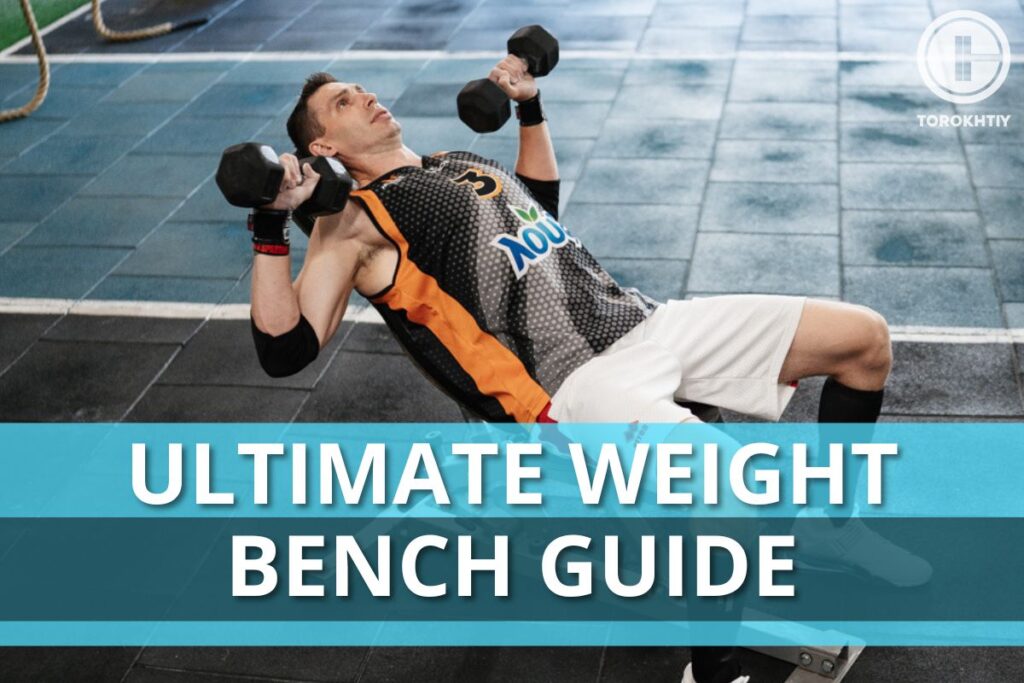
General Characteristics Of Weight Benches
A weight bench is a versatile and universal piece of strength training equipment you can utilize with free weights and as an additional tool for bodyweight exercises, and as a spotter alike that can accommodate a great range of athletes of any level. It enables them to perform multiple exercises by giving support and being a stable base while pulling heavy weights.
The design of a conventional bench is quite simple: it has cushioned padding (a flat bench itself) and steel feet. Other models may come with an additional frame consisting of two uprights to attach different accessories and work out with a barbell. Other types of benches are FID ones, meaning you can change the angles of the seat and backrest.
There are numerous options for working out on the weight bench. You can try diverse exercises targeting different muscle groups at various angles: standard barbell/dumbbell rows, pullovers, bench presses, flies, tricep extension (skull crusher), bicep curls, lateral raises, etc.
By adjusting the bench position, you’ll succeed in isolating particular muscles to improve their strength and muscular balance.
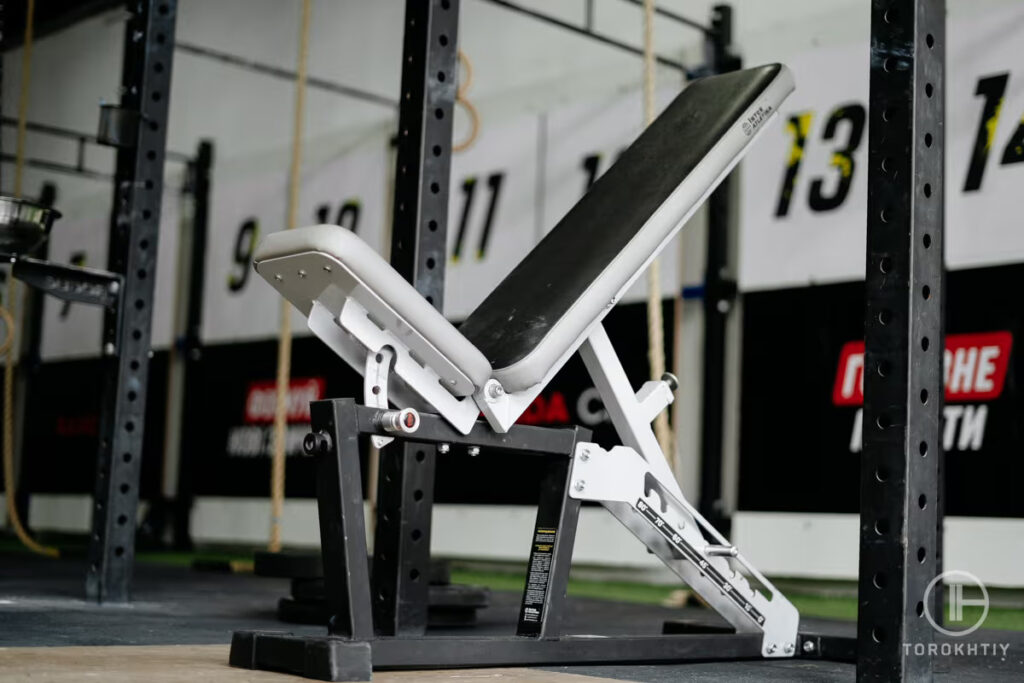
Due to the sturdy and grippy surface, you’ll be able to maintain the correct form and follow the proper technique, by lowering injury risk.
Besides toning up your chest and arms, you’ll be able to work out your quads and hamstrings by attaching leg rollers to the bench. It’ll enable you to perform leg extensions and leg curls.
Jacek Szymanowski, Strength and Conditioning Coach, with M.Sc.Eng in Biotechnology, Nutrition Specialist from WarriorsDoctor, with lifting experience of 20 years, told us a bit about his lifting experience:
“I personally use the squat rack for bench press, etc. because of the other tools I can use like safety bars etc. I don’t use a weight bench as separate equipment”.
Squat rack only with westside spacing – that allows you to set up hooks and safety bars more accurately. A squat rack for benching will also allow you to do floor press exercises.
In addition to the common exercises with free weights, you can utilize the weight bench for bodyweight workout, i.e., tricep dips, pike push-ups, feet-elevated mountain climbers, Bulgarian split squats, and so on.
3 Types Of Weight Benches: Benefits And Purposes Of Each Of Them
Despite the fact that a weight bench may appear to be a simple-looking piece of equipment at first glance, you’ll find various bench designs available on the market. If it’s a particular tool you’re looking for to add to your home gym, then get to know the peculiarities of each type of weight bench in order to choose a proper option.
1. The Flat Bench
This is the most straightforward weight bench option that attracts many lifters due to its simplicity and versatility. By the way, pro lifters also prefer training on a flat bench: it’s a great opportunity to concentrate on strength building and keep their full ROM during the workout.
It’s a bench platform that is located on sturdy legs. An athlete can lie or seat on its padding surface and work out with free weights.
As usual, this type of benches doesn’t have special features. But, it can be distinguished from other benches due to its high-quality construction that can hold heavy weights, i.e., as it comes with incredible weight capacity (up to 1000 lb). The fact is that flat weight benches can be competition-targeted tools, namely, can be compatible with the IPF standards.
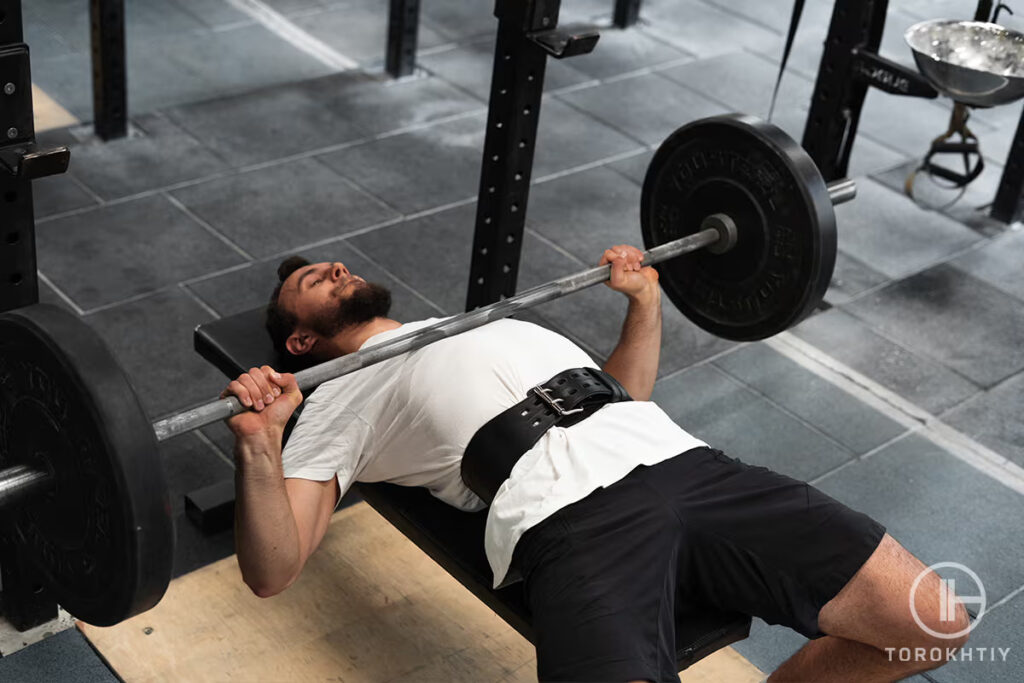
The bench can be a great addition to your home gym or utilized at a commercial gym as well. You can perform multiple common exercises with free weights on it, and also can use it as a supplementary tool for bodyweight workouts.
Tips From the Champ
A weight bench should be stable enough to avoid wobbling while lifting training. For better stability, most benches are equipped with grooved rubber feet to ensure a good grip on the surface.
Olympic Weightlifting Champion
2. The FID Bench
This bench type is the most functional one as the weight bench can be placed flat, inclined and declined position. So, you get twice more opportunities to switch between different exercises. The FID means ‘flat, incline, and decline’ and this function enables you to adjust backrest positions and seat pad heights.
Such a bench brings you a full range of motion by placing the pad at the most comfortable angle to work out as many muscles as possible.
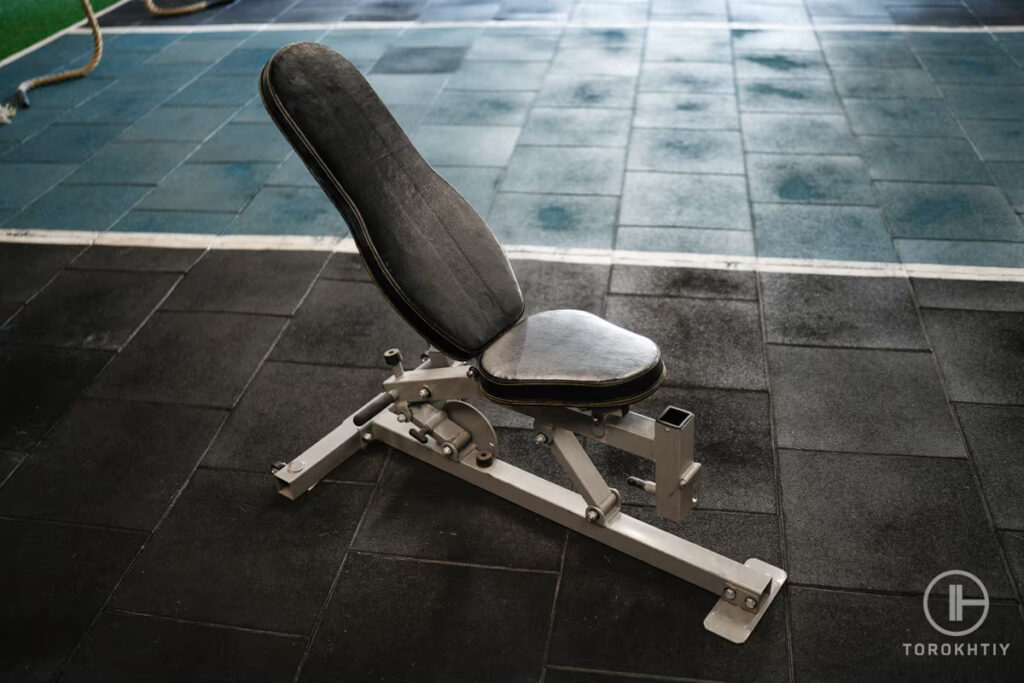
The incline bench is effective for strengthening smaller muscles that can be missed with a flat surface option. While the decline combinations can add some difficulty because of the gravity.
The FID bench also can be a great option for home gym weight bench training. However, this type of bench can require more space. Athletes of any level can work out on it as it has a wide range of adjustment settings to fit your body composition.
Jacek shared a personal tip with us:
“Get one that will allow you to use it as an incline bench as well – adjustable. Will allow you to add dozens of extra exercises as well will save your shoulders if you will be able to rotate exercises frequently”.
3. Olympic or Competition-Style Benches
Competition-style weight benches are designed specifically for powerlifting and weightlifting contests and are certified by the IPF meeting their height standards. What differs these benches from other models is that they tend to be more stable: they come with a sturdy tripod feet design that brings an optimal foot space for an athlete while lifting.
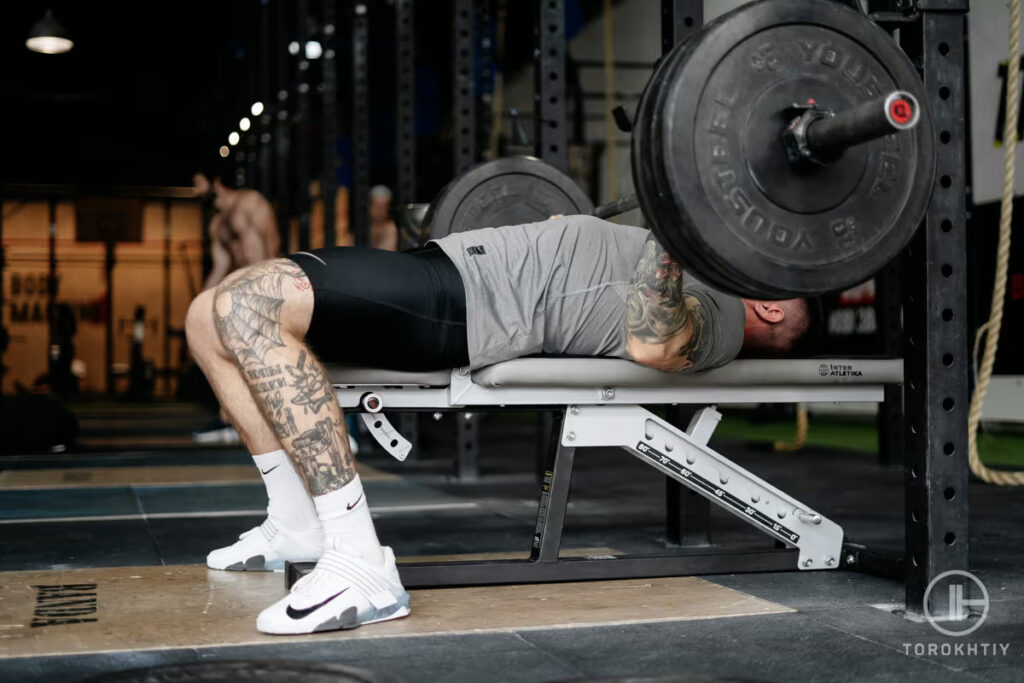
What’s about padding: a competition bench is equipped with a highly thick pad of 4” and can be compatible with other padding options, i.e., with the Thompson fat pad of 4.5”. It’s also possible to replace it to a wider one by switching from a 12” width pad to 14” or 14.5”. Also, this bench type is heavier than others and has the greatest weight capacity.
A Comparison Table of Bench Types
| Features to Compare | Flat | FID | Olympic |
|---|---|---|---|
| Target muscles | Targets more lower pecs (lower chest) | Puts more emphasis on the upper pec, clavicular head (upper chest) and deltoids (shoulders); while being declined, it places more emphasis on your lower chest | Targets more lower pecs (lower chest) |
| Weight capacity | Has a high rate of weight limit – up to 1000 lb | Has a weight limit ranging between 600 lb and up to 1000 lb | Has a high rate of weight limit – up to 1000 lb (can hold that weight, which standard benches may not be able to) |
| Adjustable | Not adjustable | Has incline/decline options | Can be flat and foldable |
| Best for | Athletes of all levels, competition athletes | Athletes of all levels | Advanced lifters |
| Types of workout | From light to competition style training | From light to vigorous workouts | For competitions and high-intensity workouts |
| Exercises | Barbell/dumbbell rows; bench presses; dumbbell pullovers; skull crusher; seated crunches, etc. | Incline bicep curls; seated lateral raises; decline sit-ups; seated dumbbell shoulder press; bench dips, etc. | Barbell/dumbbell rows; bench presses; incline bicep curls; seated lateral raises straight leg raises; bench dips, etc. |
3 Bench Adjustment Types
Possessing an adjustable weight bench gives you a great opportunity to change the seat and back angle, by bringing unlimited options for working out various muscles. The way you can adjust the angles relates to the adjustment mechanisms that are pop-pin and ladder.
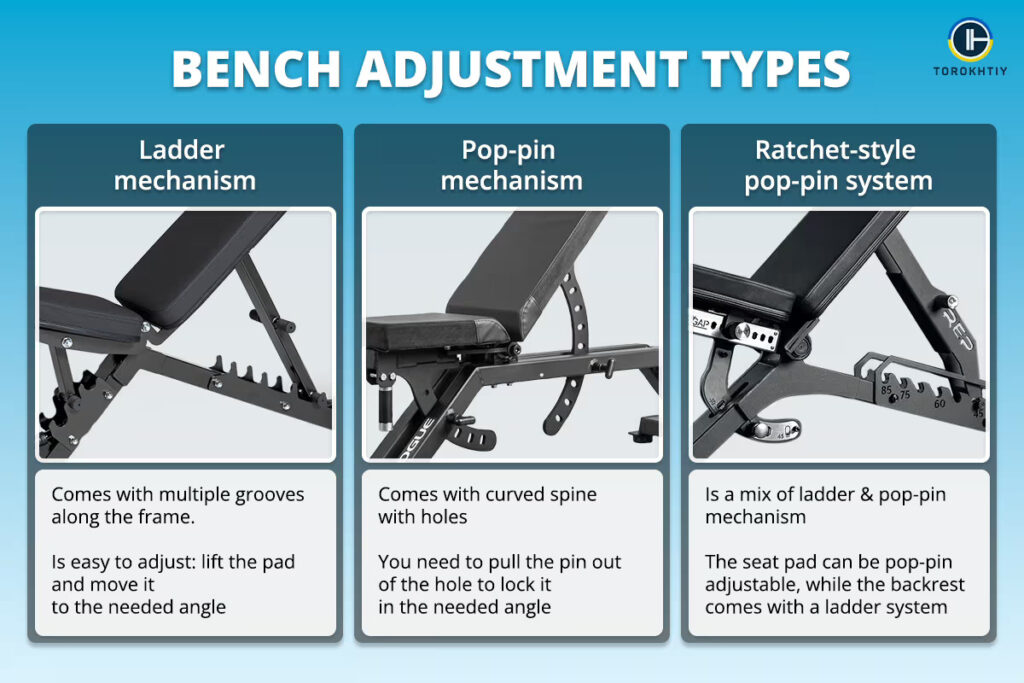
1. Ladder Mechanism
It’s easy to distinguish by simply looking at it: such a bench has numerous grooves along the steel frame. The ladder system is very comfortable and easy to use, you can adjust it with one hand. Just lift the padding and move it to the needed angle. Check it is set securely in the groove.
Some benches come with a closed ladder system, meaning it keeps the ladder securely in place when adjusting the pad positions and prevents you from lifting the ladder out when changing the angles. You can see this mechanism applied for such bunches like REP Fitness AB-3100 and Marcy.
2. Pop-Pin Mechanism
The second type of adjustable mechanism is a pin-style design featuring a knob-like pop-pin under the back or seat pad. These benches with this system typically have a curved spine with holes for different degrees.
It’s also easy to use, but you won’t change the angle as quickly as with a ladder system. You need to pull the pin out of the hole, move the pad you adjust to the needed angle, and lock the pin into the corresponding hole. This mechanism is used at Rogue AB-2 and AB-3 models, and Titan Fitness Incline Bench V3.
3. Ratchet-Style Pop-Pin System
This mechanism combines the features of both previous locking systems. What does it mean? The seat angle has a pin-pop-adjustable mechanism and the backrest features the ladder one. Altogether, these two types provide extra security for the bench construction during working with heavy weights. Several benches presented on the list, i.e., REP BlackWing and BodyChamp have this mechanism.
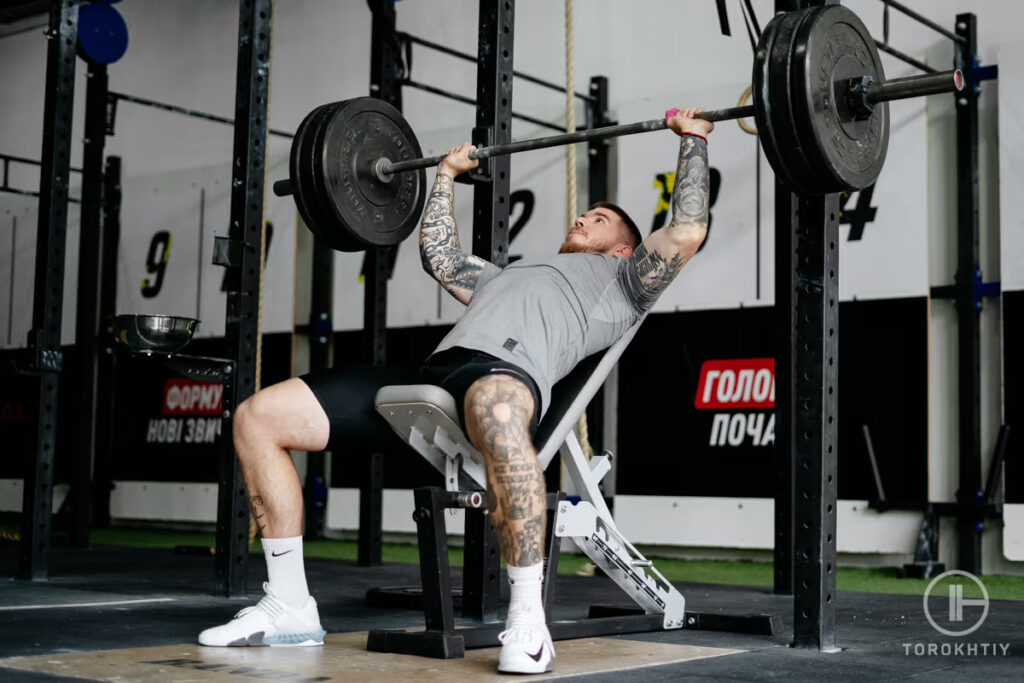
What Are the Benefits of Using Weight Benches?
A weight bench is a valuable piece of equipment for your home gym that can add up versatility to your training routine and even substitute some exercises with free weights or other training tools. As a weight bench combines everything essential in one unit. Let’s observe what benefits you’ll get by working out on the bench regularly.
✅ Versatility
A weight bench is a highly universal and versatile training tool you can use for performing numerous exercises, from common bench presses and pullovers, to incline and decline flies and even bodyweight exercises.
This equipment will work out the entire body, by engaging your upper body dominantly (namely in the incline position), leg muscles, and abs. A great perk is the opportunity to apply barbells, dumbbells, kettlebells, and other applicable pieces of equipment. Additionally, there’s a chance to attach the bench to the weight rack.
✅ Strengthening the Upper Body
By performing multiple exercises with free weights, you’ll be able to target your upper body muscles, namely arms, chest, biceps, triceps, shoulders, and lats. The reason is that working out with weights stimulates the growth hormone that increases the metabolism rate and results in muscle growth.
A particular investigation depicted that the difference between the incline and decline bench press were examined for lower and upper pectoral activation. There was no significant difference in upper pectoral portion activation during the incline and decline bench press. However, the data showed higher activation of the lower pectoral muscles.
✅ Improving Overall Physique Form And Muscle Gain
Using weight benches is a great option to facilitate general condition and muscle mass growth. Thanks to the weight bench adjustability, i.e., changing the seat and back angles, you’ll be able to focus on different muscle groups at various angles and with different ranges of motion.
For example, while using a horizontal bench, you’ll be able to achieve muscular activation of both the upper and lower heads of the pectoralis.
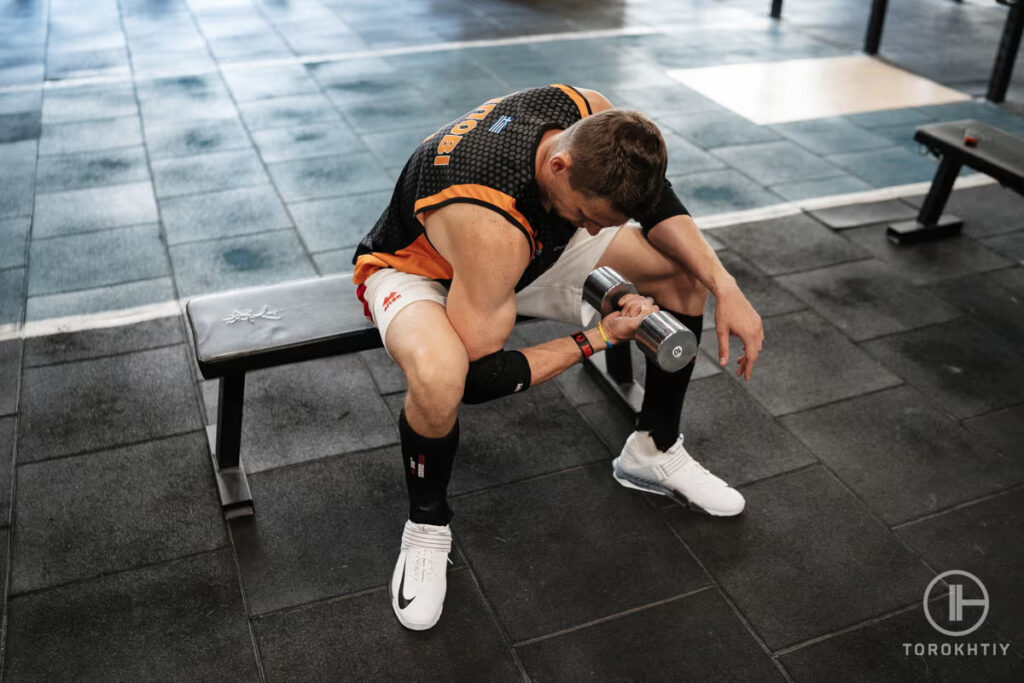
✅ Improving Bone Density
Generally, any kind of strength workout is useful for strengthening the bone structure. Each weight training with gradual load increase makes your body adapt to different resistance and pressure directing different muscles.
✅ Getting Extra Support
A weight bench is a decent tool for maintaining the right posture while lifting weights. By learning the proper technique, this tool is useful for efficiently developing your speed and quality of lifting free weights. A bench enables a user to concentrate on performing a particular exercise without losing balance.
What to Look For in Weight Benches?
Choosing the best workout bench can be a cumbersome process since there are endless bench options on the market. Before purchasing this piece of equipment, you need to think out well what your goals are, what your preferences are, and overall what you want to get by working out with a specific bench.
After reviewing the most outstanding bench models, we prepared a list of the following points you should consider when choosing a perfect bench for your needs.
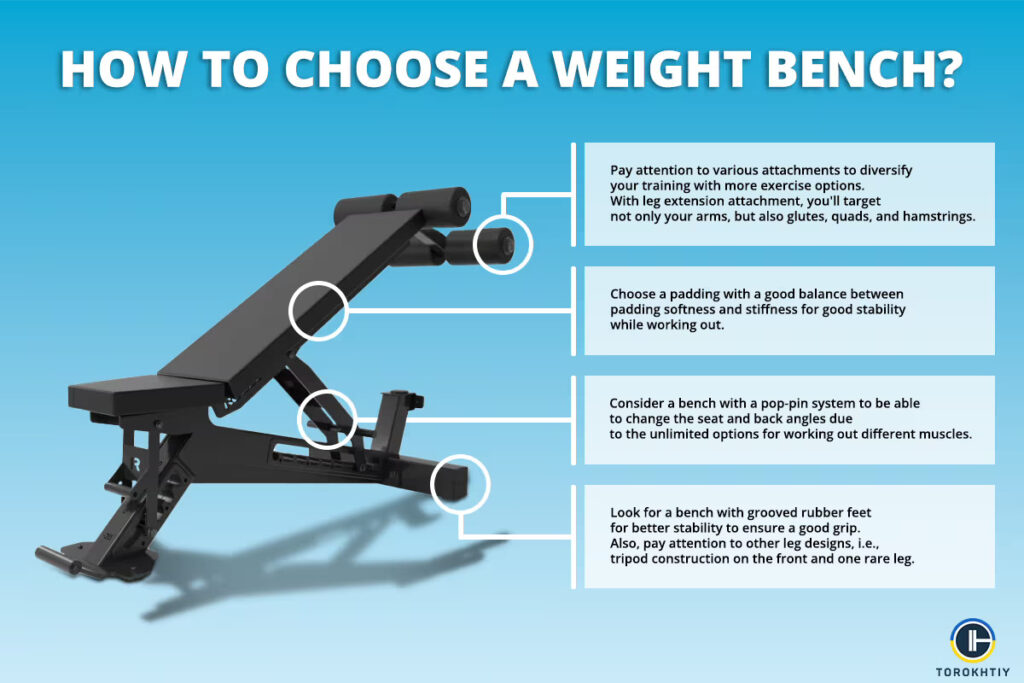
1. Design
Pay attention to the bench design and how it’s constructed, there shouldn’t be any scratches and defects on the surface and steel frame. All bolts should be welded well to provide a user with ultimate stability while working out.
Despite the variety of weight benches on the market, they have almost the same design: a cushioned surface and stable legs. Flat benches come with a flat surface you sit and lie on while training, and FID benches have adjustable seat and back pads.
2. Pad and Leather Quality
A high-quality bench has relatively firm, yet soft padding that is slip-resistant and stays stable while pulling heavy weights. It should bring enough comfort for an athlete to lie and sit on it, and give moderate cushioning for the back and pelvis.
A good balance between padding softness and stiffness vouches for good stability while working out. Additionally, the cover material should be grippy enough and absorb liquids to avoid slippage. The padding density should be at least 2”.
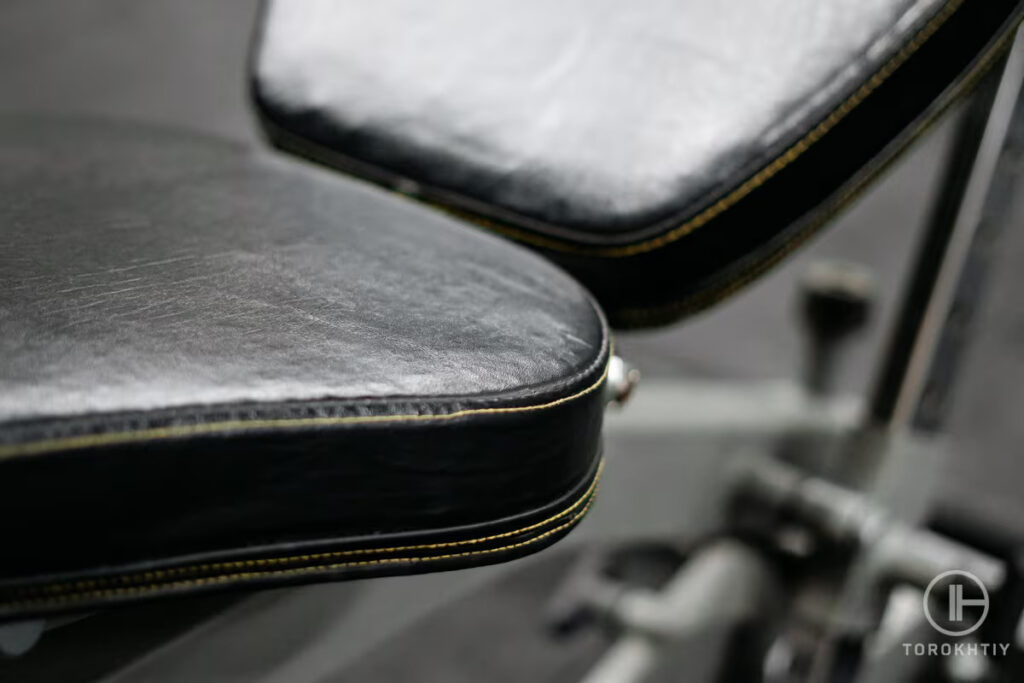
3. Stability: Construction and Mechanism Details
A weight bench should be stable enough to avoid wobbling while lifting training. The majority of tools are made of alloy steel of different gauge densities and thickness grades that can vary throughout the frame.
The overall construction of the majority of the benches is durable and moderately weighty which brings sufficient stability and a lifter can be more confident in pulling heavy weights. For better stability, most benches are equipped with grooved rubber feet to ensure a good grip on the surface. They also have different leg designs, like a tripod construction on the front and one rare leg.
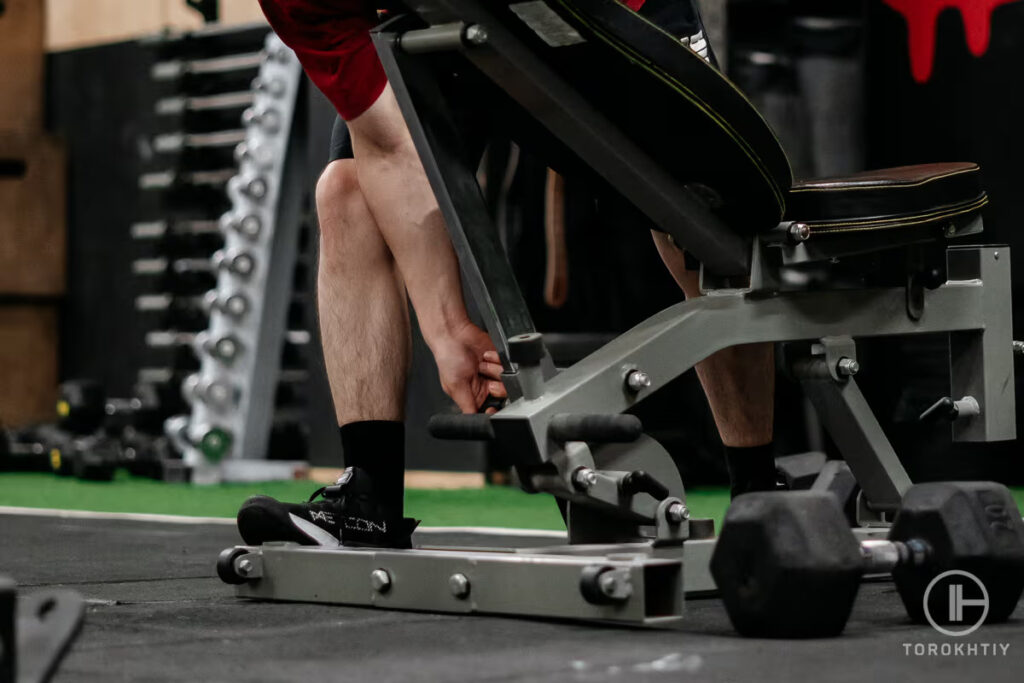
4. Adjustability
If not consider flat benches, have a look at FID benches that can be positioned at various angles due to the incline and decline settings. You can change the position of the seat and backrest which vouches for high customization that allows to accommodate the tool to a wide range of athletes of various body compositions.
By switching the incline and decline angles, you can get more range of motion and more workout options. For instance, you can have 0, 30, 45, 60, 75, and 90 degrees for the back and 0, 10, and 20 degrees for the seat adjustment options, as well as adjust the decline angle of -10 to -35 degree settings.
Studies showed the comparison of the horizontal and incline bench presses, as well as their combination, and their effect on neuromuscular adaptation. The results indicated similar changes in overall strength and conditioning.
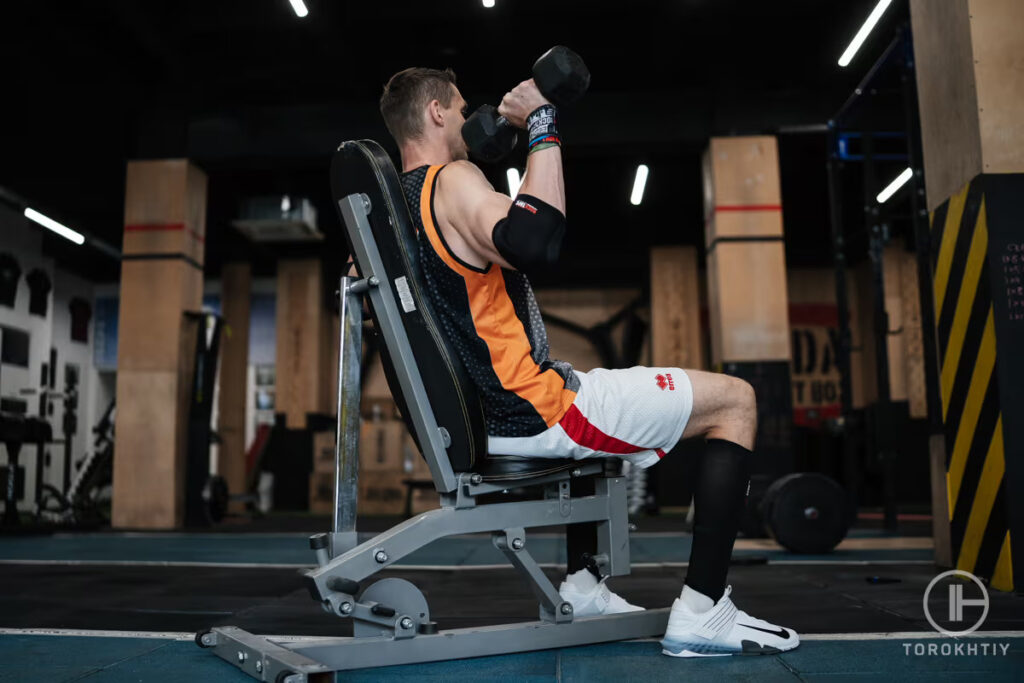
5. Weight Capacity
This indicator is one of the most important aspects you should check before choosing the bench. It depends on how much you could lift which affects the intensity of your training.
Our expert Jacek Szymanowski added:
“Get a bench that can support more than 300kg (make sure you get one that can easily handle your weight and the weight you are lifting). Get one that has nice support – is really stable side to side. Get one that will allow you to put your feet on the floor properly”.
If you’re an advanced lifter, benches with high weight capacity will work for you and will satisfy your lifting ambitions. The majority of premium-quality best gym benches can withstand up to 800-1000 lb, unlike some budget-friendly benches with around 600 lb of maximum weight capacity.
Everything depends on your needs and goals: if you’re a beginner, prefer benches with a lower load rating, it’ll be enough for a good start. But, if you’re a regular gym-goer, getting a bench with a maximum capacity will be the right choice.
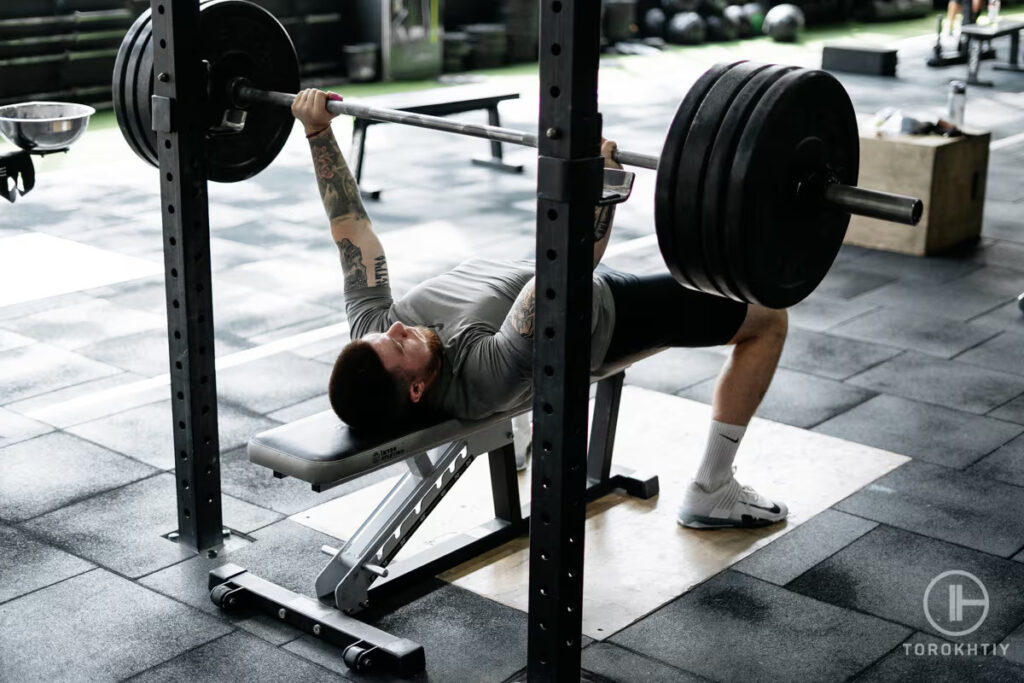
6. Attachments
You’ll find various attachments to upgrade your weight bench and diversify your training with more exercise options. You’ll be able to target not only your arms but also activate core and leg muscles, so you’ll get a full-body workout just by adding different accessories.
There are crunch sit-up attachments, bar dip handles, leg developer attachments, preacher curl pads, etc. that will bring you to the next level in mastering your technique.
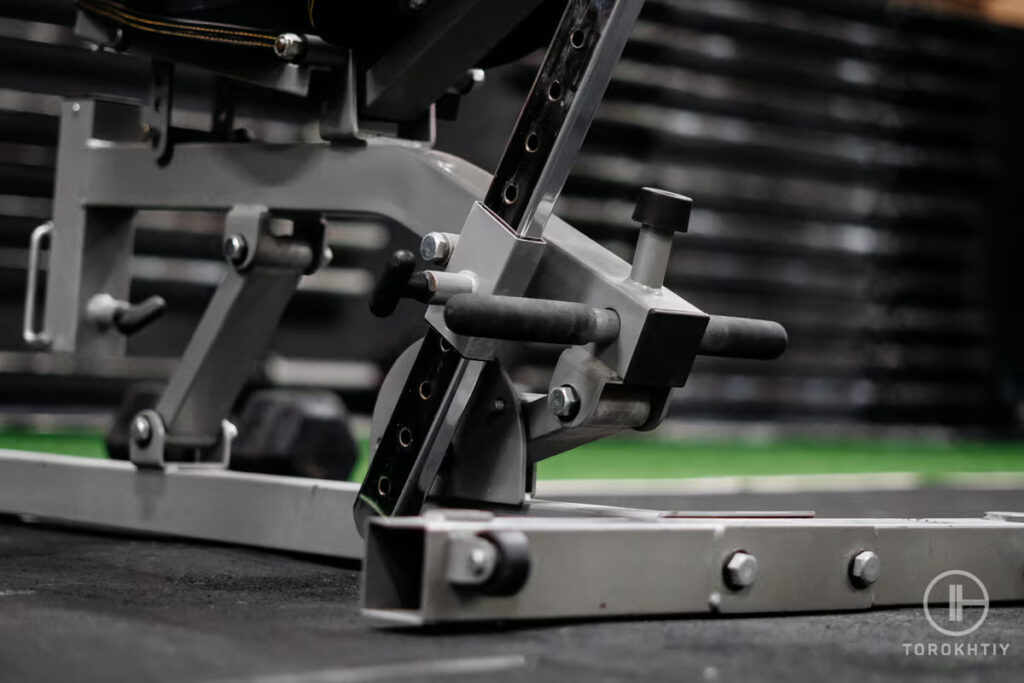
7. Price/Quality
The price for a weight bench directly depends on the manufacturer’s brand, materials used, construction quality, weight capacity, and adjustment options available.
Consider well whether you need a high-price bench if you just start to lift weights and have no experience in weight training progression. It’s better to pick up average-level equipment that won’t sacrifice the quality and will have sufficient options for you to vary your training routine.
REP Fitness AB-3100 Adjustable Weight Bench
- Adjustability: 6 back pad adjustments, 3 seat angle options
- Folding: no
- Material: 14- and 4-gauge steel
- Color palette: metallic black, matte black, red, blue
- Item weight: 70 lb
- Weight limit: 700 lb
- Product dimensions: 50.5” L x 23” W x 16.75” H
- Transport wheels: 1 pair of wheels available
- Additional features: not available
The AB-3100 bench is a heavy-duty and highly sturdy tool with a flat-incline feature and no decline position. The bench requires 7.9 ft² of space to place at your home gym. It comes with three posts, so the bench legs won’t bother your feet while pressing weights.
So, what adjustments you’ll get: 6 back pad adjustments from the flat position to 90 degrees, and 3 seat angle options from flat to 20 degrees. Overall, you have 0, 30, 45, 60, 75, and 90 degrees for the back and 0, 10, and 20 degrees for the seat. The seat height ranges between 16.5” and 17.75”.
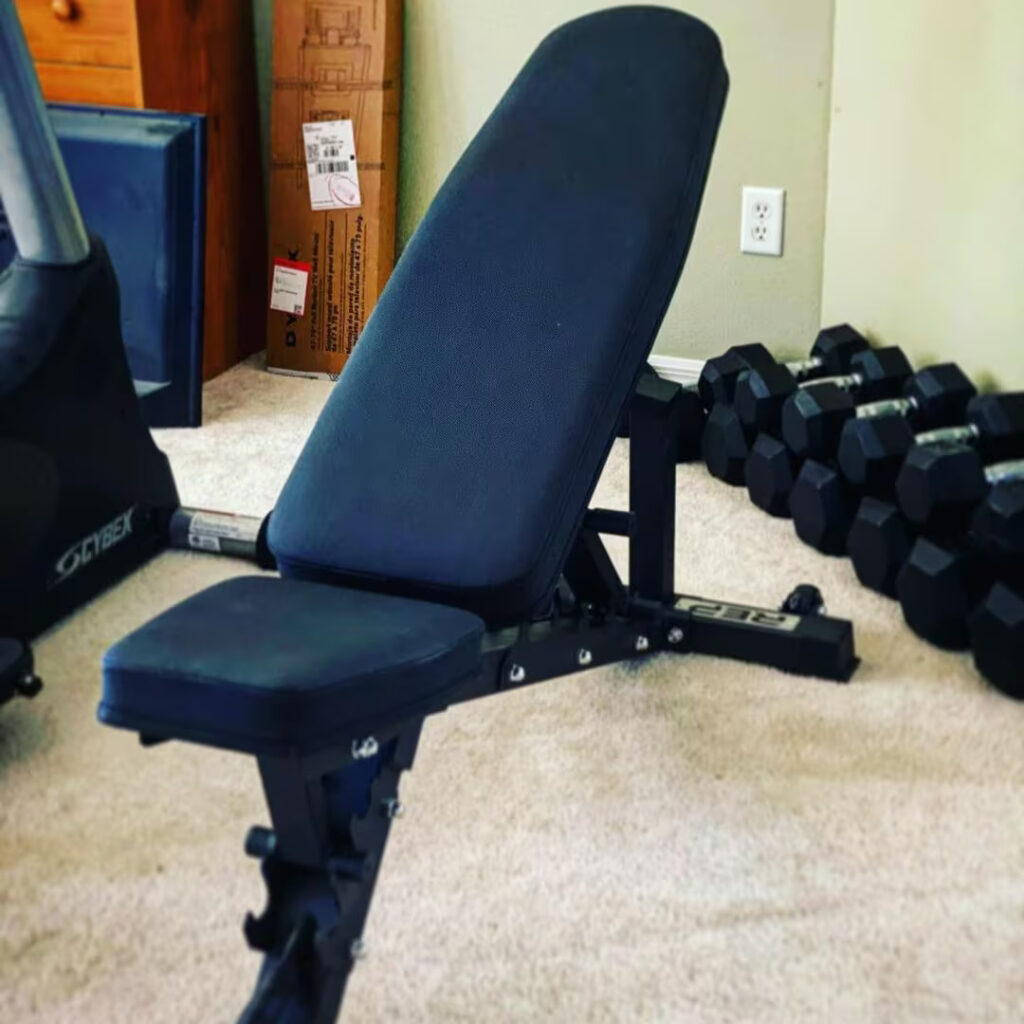
REP Fitness bench stands out from the rest with its first-class steel frame with variable thickness. It combines 14- and 4-gauge steel in its frame which vouches for high durability.
The back and seat pads are covered with a non-slip, textured vinyl that helps you to keep securely in position. The bench pads also feature a minimal gap of 1.75” between the back and seat pads.
How to Use Weight Benches Right?
Considering the variety of weight benches, it’s important to know how to use this tool correctly to benefit from it and not get injured because of a lack of knowledge about the correct settings and how to keep your body and hold the weights properly. Let’s outline shortly how to incorporate the weight bench into your training routine and choose the right adjustments.
1. Adjusting a Back and Seat Padding
Depending on the adjustment system, manage the bench angle position properly. If it has a pin system, locate it to the needed level, by giving a little tug to pull it out from the hole to adjust the back pad position. Choose the needed incline and pull the pop pin into another hole. Move the bench pad if needed and click it into the right place.
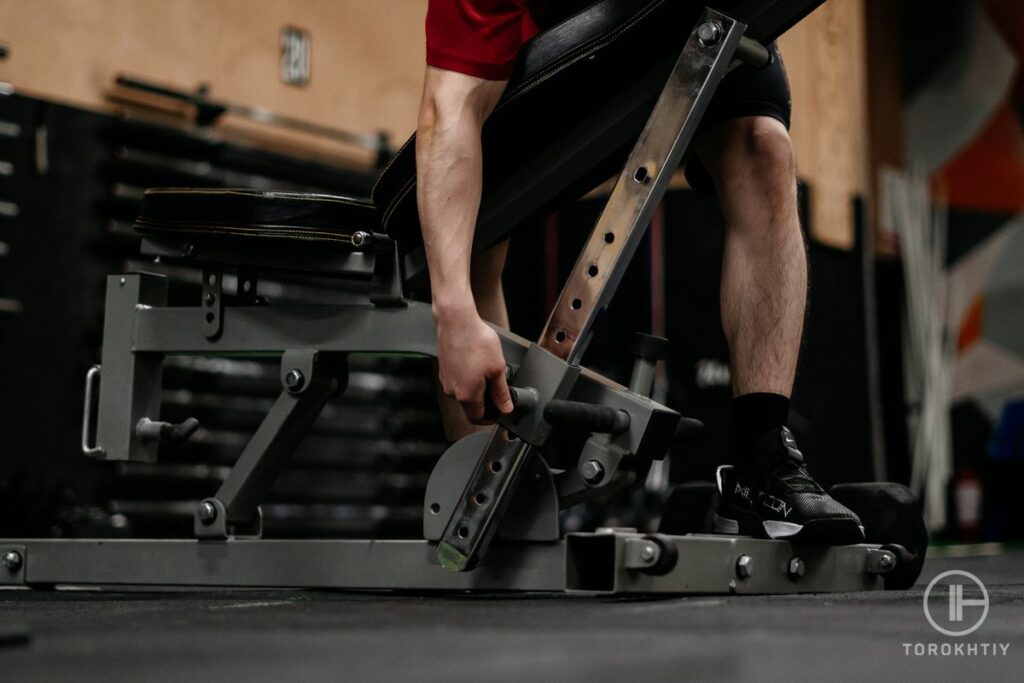
If your ladder comes with a ladder system, then just move a backrest up or down to place the back holder into the needed ladder groove. All you need is to up or down the pad with your hands. Check the bench stability by pressing on the back and seat padding to ensure that it’s in place and fixed securely.
2. Don’t Be Afraid To Experiment With A Bench Position
Vary the incline/decline settings of the bench to target various muscles and increase or limit your range of motion. This way you’ll make your body get accommodated to different loads at different positions.
For instance, when performing a dumbbell chest press, you need to place the bench at the incline position to activate the upper chest muscles. Don’t set the angle too to avoid putting much tension on the shoulder joint. Upgrade the angle and weights gradually and always listen to your body.
Our expert Jacek Szymanowski also mentioned:
“When you lift alone and lift already fairly heavy, get one with safety bars – end of story. Quality and durability of the bench are obvious but I will say it – shit needs to be thick and the bench must be quite comfortable for your back – but not soft”.
3. Keep the Right Technique and Body Form
While working out on the bench, whether performing exercises by lying or seating on the pad, don’t arch your back, especially if you use too heavy weights. Try to keep it straight and engage the needed muscles for doing the intended exercises. Also, keep your feet flat on the ground, don’t lift them up to help you press the weights. It could lead to an unstable position and result in injury.
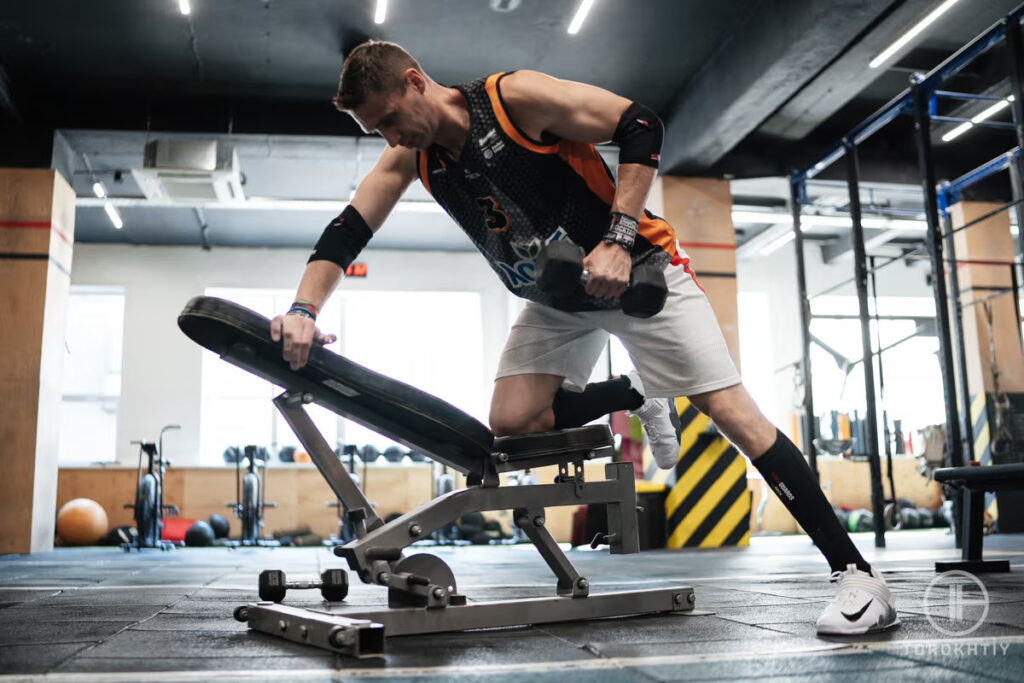
9 Tips on Using a Weight Bench Safely
No matter what type of the bench you prefer to work out, it’s important to preserve the proper form and technique while performing lifting exercises. Follow these tips before and during working out on the bench:
- Warm up before pulling the weights to get them prepared for the training. It helps to increase blood flow throughout the body while maintaining the needed oxygen levels to preserve high energy levels.
- If you’re a beginner, you’d better start pulling weights with a personal trainer who can act as a spotter. A fitness expert will assess your general form and performance level, and will watch you performing the exercises correctly. He’ll also prevent you from occasional weight drop and will encourage you to do more reps.
- Avoid hurting your chest by lifting too heavy, so the bar falls down onto your chest. Use a spotter, or exercise on the bench attached to the power tower with safety pegs to help you press the bar back up and locate it securely.
- Keep your wrist straight and fixed, not bent or cocked to increase your bench press safety. Your grip should be one and a half shoulder widths, as this will prevent pressure developing in the wrist and forearm.
- Keep your chest out and shoulders blades pulled back (when performing the bench press exercise).
- Do not let the bar touch your chest at the bottom while performing the bench press. Lower the bar with your elbows at 90 degrees and no lower.
- If you have no more strength to lift the bar off your chest, you can tilt your body to the side and let the weights slide off the ends.
- After you complete any dumbbell exercise (chest fly or press), bring the weights to your chest and then gently rock yourself up into a sitting position.
- When you have finished a set, don’t drop them off, place the weights on the floor gently.
Additional equipment and accessories are also vital for protecting you from injuries. For instance, you can wear wrist straps that will provide you with better grip and wrist support. Also, it’s recommended to wear proper shoes that will be grippy enough: it’s better to select training shoes with flat soles without a bounce effect, even Chuck Taylors will work.
To sum up, you should make gradual progress in lifting weights. Becoming stronger and more endurant requires time and persistence, along with a properly built training program.
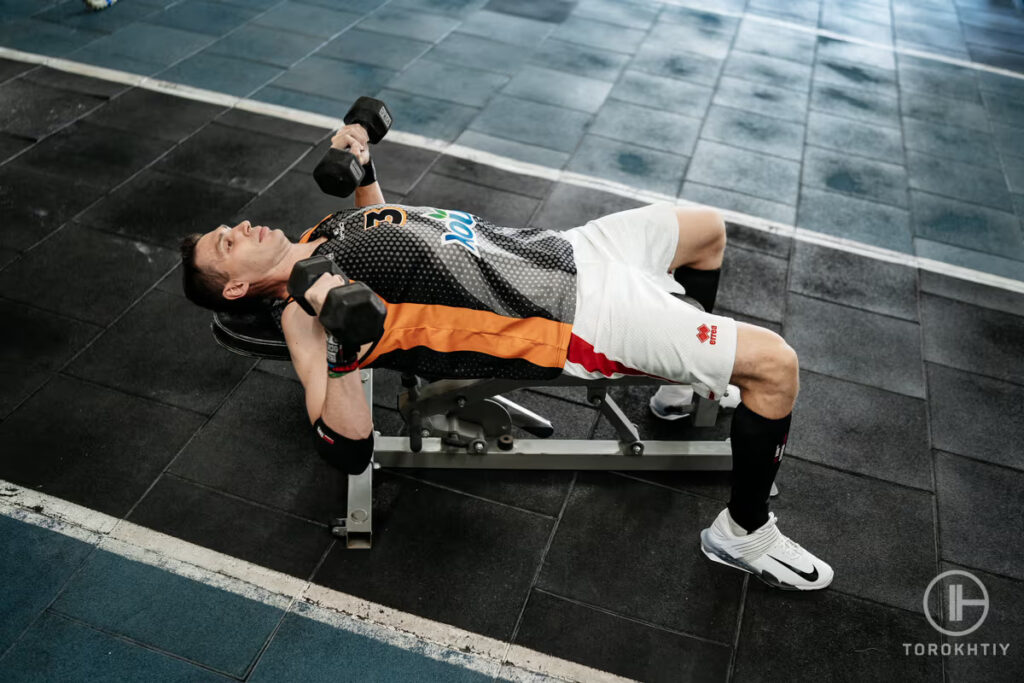
FAQ
Are Weight Benches Worth It?
Sure, weight benches are decent training tools that are very versatile and can be adjusted specifically for an athlete’s height and training preferences. You’ll be able to work not only your upper body, but also your legs, and abdominals by adjusting the bench position.
How Much Should I Pay for a Weight Bench?
The cost of a weight bench may vary depending on its type, manufacturer, and functionality. It’s possible to find a budget flat bench for $150 and a prime-quality one for around $700 because it’s designed by a reputable company. An adjustable bench can cost in the range of $300-$800 depending on the frame quality and adjustability settings.
Is an Inclined or Flat Bench Better?
The incline bench press focuses more on the upper pecs, upper chest, and deltoids. It develops the upper portion of the pectoral muscles. When the bench is set at the 15 to 30-degree incline, you activate your shoulders more since it’s comparable to a shoulder press.
While the flat bench press exercise does a better job of developing your lower pecs (lower chest). However, many coaches state that the incline press is safer on your pecs, shoulders, and rotator cuff.
Can You Build Muscle With Just a Bench?
Yes, you can build up muscles by performing weight bench exercises. This is a decent tool to strengthen your upper body, namely shoulders, arms, and pectorals. By changing the angle of the back or seat position, you can target specific muscles. What’s more, you can also work out your core, glutes, quadriceps, and hamstrings.
The final verdict
Choosing the right bench is very important if you want to improve your workout experience. A good weight bench offers versatility and allows you to do a lot of different exercises safely and effectively.
Before you choose one, make sure it really suits your space and needs – whether it’s a flat bench that can cover the basics, an adjustable one for varied angles, or an Olympic bench for some serious lifting. Pay attention to features like weight capacity, padding, and adjustability to make sure you’re getting a tool that’s comfortable and supportive.
In our opinion, you can’t go wrong with the REP Fitness AB-3100 Adjustable Weight Bench. It provides 72 combinations with 12 adjustable back positions and 6 adjustable seat positions.
Also, it comes with dual adjustment systems: a ratcheting system at the seat padding and a closed ladder design of the backrest. What’s more, the bench takes just 3.1ft² of space, making it compact while storing upright. Besides these options, it’ll bring you other perks to get the maximum out of the training.
What are your thoughts on weight benches? Do you use one? Do you have one to recommend?
Leave your comments below and let’s discuss!
Experts Who Contributed To This Article
M.Sc.Eng. Biotechnology, Sports Nutritionist

Also Read:
References:
- Suene F N Chaves, Valdinar A Rocha-JÚnior, Irismar G A EncarnaÇÃo. Effects of Horizontal and Incline Bench Press on Neuromuscular Adaptations in Untrained Young Men. International Journal of Exercise Science, no.13(6) (2020): 859–872.
- Glass SC, Armstrong T. Electromyographical activity of the pectoralis muscle during incline and decline bench presses. Journal of Strength and Conditioning Research, no.11(3) (1997): 163–167.
- Lauver JD, Cayot TE, Scheuermann BW. Influence of bench angle on upper extremity muscular activation during bench press exercise. European Journal of Sports Science, no. 16(3) (2016): 309–316.
- David Rodríguez-Ridao, José A Antequera-Vique, Isabel Martín-Fuentes, José M Muyor. Effect of Five Bench Inclinations on the Electromyographic Activity of the Pectoralis Major, Anterior Deltoid, and Triceps Brachii during the Bench Press Exercise. International Journal of Environmental Research and Public Health, no. 17(19) (2020): 7339.
- Evan E Schick, Jared W Coburn, Lee E Brown, Daniel A Judelson, Andy V Khamoui, Tai T Tran, Brandon P Uribe. A comparison of muscle activation between a Smith machine and free weight bench press. Journal of Strength and Conditioning Research, no. 24(3) (2010): 779-784.
- Photos are made by Torokhtiy Media Team.
Why Trust Us?
With over 20 years in Olympic weightlifting, strength training, nutrition coaching, and general fitness our team does its best to provide the audience with ultimate support and meet the needs and requirements of advanced athletes and professional lifters, as well as people who strive to open new opportunities and develop their physical capabilities with us.
By trusting the recommendations of our certified experts in coaching, nutrition, and sports training programming, as well as scientific consultants, and physiotherapists, we provide you with thorough, well-considered, and scientifically proven content. All the information given in the articles concerning workout programming, separate exercises, and athletic performance, in general, is based on verified data.
The product testing process is described in more detail here.
Author: Oleksiy Torokhtiy
Olympic Weightlifting Champion
Best Results: Snatch – 200 kg,
C&J – 240 kg
Oleksiy Torokhtiy is a professional athlete boasting 20 years of experience in Olympic weightlifting. With multiple European and World titles under his belt, he has showcased his prowess in two Olympic Games (Beijing 2008 and London 2012). Upon concluding his illustrious career, Oleksiy dedicated himself to coaching. By 2022, he had conducted over 200 weightlifting seminars worldwide. He is the visionary behind an international sportswear and accessories brand known for its motto, “Warm Body Cold Mind.” Additionally, he is an esteemed author and the creator of a series of training programs and eBooks.
Reviewed by: Sergii Putsov
Head of Sport Science, PhD
Best Results: Snatch – 165 kg,
C&J – 200 kg
Sergii Putsov, Ph.D., is a former professional weightlifter and National team member, achieving multiple medals in the 94 kg weight category at national competitions. With a Master’s degree in “Olympic & Professional Sport Training” and a Sport Science Ph.D. from the International Olympic Academy, Greece, Sergii now leads as the Head of Sport Science. He specializes in designing training programs, writing insightful blog articles, providing live commentary at international weightlifting events, and conducting educational seminars worldwide alongside Olympic weightlifting expert Oleksiy Torokhtiy.





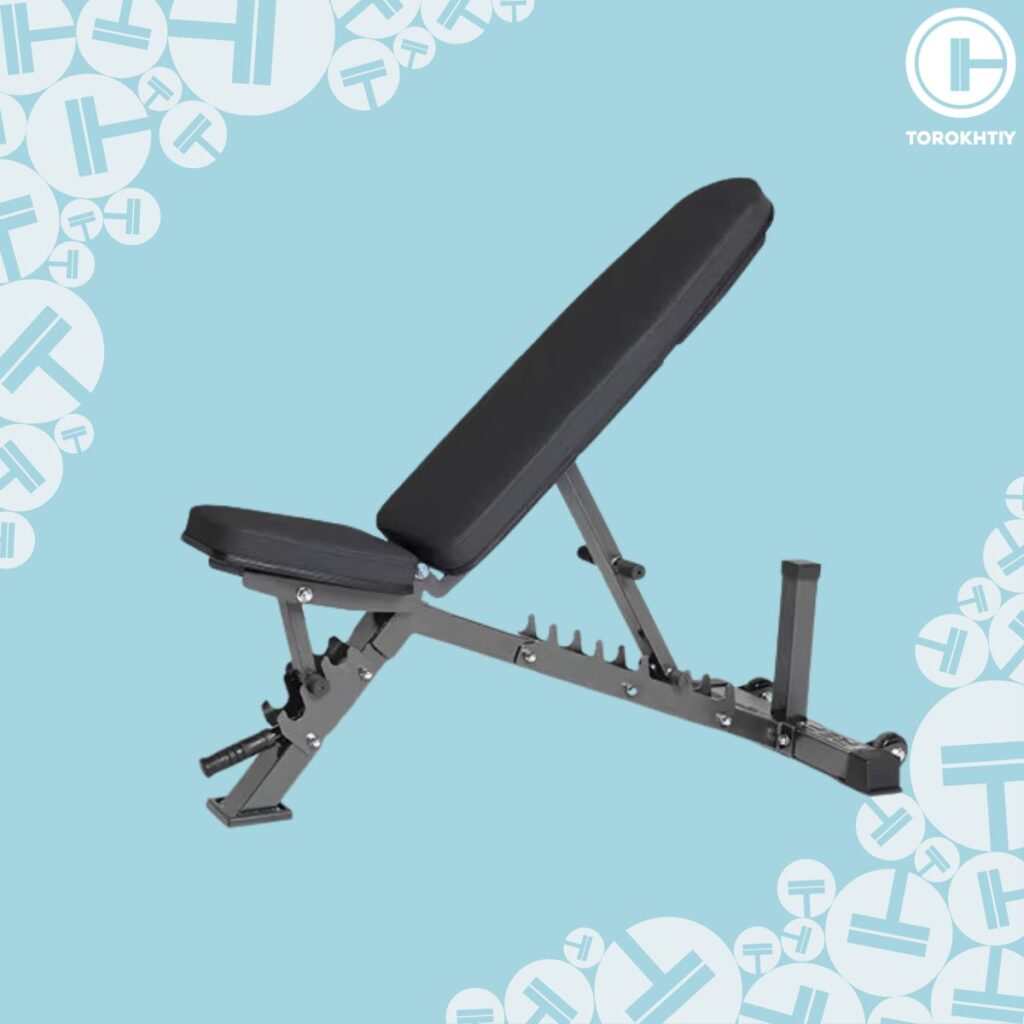

Still have questions after reading our article? Unlock your full potential by engaging with our experts and community! Don’t hesitate — leave a comment below and Oleksiy Torokhtiy will provide a personalized answer and insights to help you reach your goals.